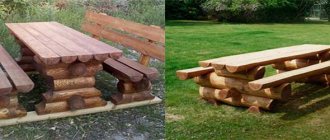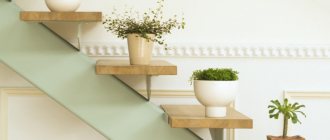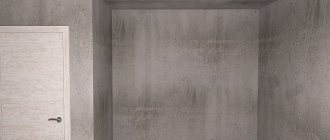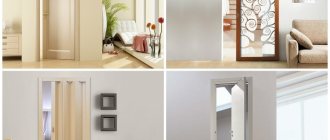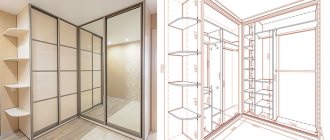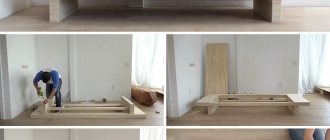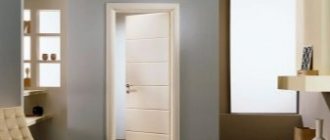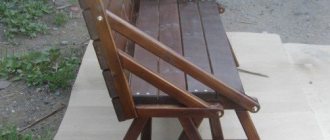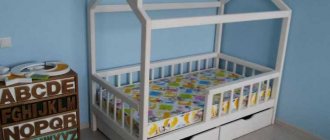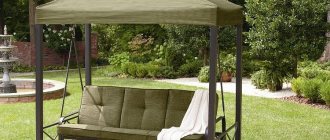Do-it-yourself features
Why even bother with such a complex campaign? In fact, there are plenty of arguments in favor of creating a door on your own. Here are some of them:
- the presence of a non-standard opening - ordering a non-standard door in a workshop will cost much more. If the dimensions of a product go beyond the standards, its price soars at jet speed;
- the inability to purchase a suitable model that will fit into the design and be combined with other interior elements;
- desire to save money - if there is an opportunity to make a budget door from natural wood yourself, and not buy a ready-made one for crazy money, why not take advantage of it;
- the presence of outbuildings in the courtyard of a private house - a barn, a bathhouse, a barn - they have no need for expensive doors;
- the desire to create a unique, inimitable product and to know that you made this wonderful door yourself.
Required tools and materials
To start making paneled door panels with your own hands, you should take care of preparing all the necessary tools and equipment. Since you are going to be turning out fragments from scratch, it is important to have all the suitable attachments available. To complete the entire process from start to finish, first of all you will need:
- roulette;
- pencil;
- sandpaper;
- hacksaw for wood and wood materials;
- a circular saw;
- awl;
- level;
- drill;
- knife;
- pliers;
- screwdriver;
- chisel;
- milling attachments.
You should also take care of preparing fasteners and fittings in advance; you will need hinges, a handle and a latch lock. In addition, stock up on small nails without heads and wood glue or PVA.
Fasteners and accessories
What type of wood to choose
One of the most critical stages is the choice of source material. Each type of wood is endowed with special mechanical and physical qualities. It is necessary to know the features of different types in order to determine which one is ideal for solving a particular problem. All wood can be divided into two categories - deciduous and coniferous.
Hardwood
This series contains the most valuable species, endowed with extraordinary strength, high density, expressive texture and attractive natural shades.
Wood has the highest value:
- beech;
- nut;
- mahogany.
If there is no reason to spend money on expensive raw materials, you can get by with more affordable ones. Pay attention to the advantages:
- cherries;
- oak;
- ash
These rocks also have high strength, but will not require such significant costs as representatives of the first category.
Oak wood is very durable and resistant to rotting. Due to the content of tannins, which react with dyes during etching, it allows you to achieve intense color effects. Processing the material is not difficult - it lends itself well to simple tools. Making parts of unusual, curved shapes from it is not a problem.
Ash is as hard and durable as oak. However, this material requires regular treatment with antiseptic compounds. Otherwise, when the first wet season arrives, it will begin to rot.
Conifers
Coniferous wood never loses its popularity. This is explained by its availability and a wide range of positive qualities. The most popular materials are those made from pine, followed by spruce.
The strength characteristics of pine are slightly lower than those of deciduous trees. This disadvantage is more than offset by high resistance to biodegradation, mold and mildew, excellent thermal conductivity and extraordinary flexibility during processing. High air and moisture permeability guarantees decent quality of treatment with protective compounds.
Spruce is more susceptible to rotting compared to pine, but has less hygroscopicity and thermal conductivity. Products made from this material retain their original shape much longer.
If you choose between these two species, you should give preference to pine.
Deciduous tree wood is ideal for making interior doors. And for entrance structures, pine would be the best choice.
Help with decoration
After making the door, the last stage is decoration. Such manipulations are carried out not only for aesthetic reasons, but also in order to enhance the strength and reliability of the canvas. When using natural wood, the surface is covered with stain or varnish. With the help of such impregnation, a film is created that protects the material. The varnish also protects the finished product from high humidity.
In addition to these types of processing, you can use a paint coating, for example, in some neutral or, on the contrary, extraordinary color (if the interior requires it). If this option is not suitable, then it is possible to finish it with veneer or, for example, decorative film.
Decorated look
The option of creating a contrast between the door and the panel is often used. That is, you can paint the vertical and transverse planks, and decorate the existing inserts with an unusual pattern or paint them in a different color scheme.
If you pay attention to the presence of glass, you can also decorate it yourself. For this purpose, special decorative materials are used. You can create a unique design or an unusual stained glass window. If you wish, you can depict family photographs or other pictures you like that bring positive emotions every day.
Making beautiful doors yourself is easy and without the help of qualified specialists. They will have not only a functional character, but also a decorative one, as they will express the individuality of their owner. In addition, you will be able to show not only your true skills, but also please your entire family and friends.
And see how the manufacturing process takes place and all its details in our video. You can take more useful information from it.
Types of doors by design
Doors are classified according to various criteria - the design of the door leaf, the method of opening.
The following types of door leaves are distinguished:
- massive;
- paneled;
- panel;
Groups of door structures by opening method
- hinged - with one or two doors;
- sliding – so-called compartments, equipped with a guide system;
- folding - doors resemble an accordion or a book;
- radial.
To make wooden doors, boards, beams, and furniture panels are used. To decide on the choice of material, you need to understand the pros and cons of each of them. Let's look at the characteristics of the various options.
Massive doors
To make doors from solid wood, planed or grooved boards of large thickness are suitable. The latter are convenient because they are easily combined into a single fabric without forming cracks. This becomes possible thanks to the locking system, which consists of a longitudinal protrusion and a corresponding slot on the edges of the board. The canvas, made up of boards, is fastened with transverse or diagonal jumpers.
When making a front door, you should give preference to more expensive breeds. Oak, larch or cedar are suitable. For outbuildings, budget options are quite suitable - pine, linden or spruce.
Panel doors
This is a separate category of doors with its own design features. Their canvases consist of a frame and rectangular inserts - panels.
The main load-bearing element of this structure is the frame, which is otherwise called the frame. The remaining elements are attached to it - wooden inserts. The harness is usually made from solid wood. Glued laminated timber will also work. Four parts connected to each other form a frame. The bottom element is wider than the top and side panels. This provides the structure with additional strength. You can further strengthen the bottom of the door by covering it with sheet metal. Galvanized steel or aluminum will do. This is especially true for strengthening entrance panels.
No less important elements are the transverse strips - in other words - the middle ones. They are bars that are attached horizontally in the middle of the future canvas.
And finally, the details that gave the name to the entire structure - panels. These fragments are inserted into the frame, resulting in the formation of a single piece. Special grooves are provided for their installation. The panels are attached using a tongue-and-groove system or decorative beads, which allow you to quickly and without damaging the door replace the damaged element. Panels can be made from chipboard, MDF, plywood and even glass. They are installed in the door frame, and in addition to their main purpose, they also have a decorative function. They are given interesting shapes and decorated with carvings or paintings.
Panel doors
The design of the panel door is much simpler than the previous version. It consists of a box and the main part - the shield itself. Fiberboard, veneer or laminate are suitable for making the box. The frame is first made from boards. It is advisable to use sheets of chipboard, MDF or fiberboard as a shield.
Panel sheets can be:
- solid - made from interconnected bars;
- hollow - a frame of connected beams is sheathed with lamellas;
- small-hollow - have a variety of fillings, for example, honeycomb.
Benefits of DIY
If during the renovation process you and your whole family decided to install doors, this does not mean that you should go to the store to buy the finished product. For those who have at least some skills in home craftsmanship, it will not be difficult for them to build it themselves, without resorting to outside help.
Let's look at the advantages of making it yourself:
- Price. When you make it yourself, you will save a significant amount of money compared to the ready-made version presented in the store;
- When installing it yourself, you do not need to make additional adjustments, since the measurements taken will initially come to the rescue;
- The paneled version of the installation differs from its analogues mainly in that it is less exposed to external influences and is practically unaffected by various temperature indicators.
Necessary materials and tools for making doors
Before you start, make sure you have all the tools available. If something is missing, it is better to purchase the necessary tools in advance than to discover their absence during the manufacturing process.
So, for work you will need:
- a workbench or large, durable table;
- hand router for wood - with its help you can easily form grooves, holes, grind the surface and trim the corners of the product;
- plane - it will be an excellent assistant in leveling and grinding the ends;
- regular hacksaw;
- different-sized chisels;
- rubber hammer;
- regular hammer;
- sandpaper, or even better, a sanding machine;
- building level, tape measure, pencil;
- screwdriver or Phillips screwdriver;
- self-tapping screws of various calibers;
- wood glue.
Materials are purchased depending on the type of door chosen and its manufacturing technology. It can be:
- grooved or planed boards;
- particle boards;
- plywood;
- glass;
- laminated timber.
The preparatory stage of manufacturing a paneled door
To make a paneled door with your own hands, in addition to desire and certain skills in working with wood, you will need a relatively small set of tools:
- tape measure and pencil;
- wood hacksaw;
- sandpaper with coarse and fine grains;
- chisel;
- screwdriver.
Related article: Interior of a bathroom combined with a toilet
The materials needed to make a door include the following:
Tools for installing panel doors.
- to create a box you need thick boards, the width of which should be up to fifty millimeters, you can use a special beam, in total you need three pieces: two for making the vertical part and one for the upper transverse part;
- to create a frame you need fairly strong beams and slats, reliability depends on their strength;
- to make panels you need to purchase chipboard, plywood or glass;
- in some cases, you need to purchase a bead to secure the panels, in particular, this is necessary if the panels are made of glass;
- For fastening you need glue and screws;
- you need to stock up on fittings (door hinges, handles, locks);
- Don’t forget about finishing materials (paint, varnish, various specialized coatings), which are selected depending on the operating conditions and design concept.
Having decided to make a paneled door with your own hands, you first need to decide on the materials from which it will be made.
For the manufacture of door frames and frames, it is better to choose durable wood species that are quite resistant to changes in temperature and humidity. It is the right material that will help make the door resistant to various external influences and reliable. As a rule, it is better to choose durable wood species, such as oak or ash.
Assembly diagram of a paneled door frame.
Pine is the most inexpensive and accessible species that is resistant to changes in temperature and humidity, which is why it is often chosen as a material for making doors. For the optimal choice of specific wood, you can consult with a consultant in the store.
To make panels, you can use plywood or chipboard; they make the structure light and inexpensive. If you wish, you can buy more expensive solid wood to make panels; this will make the door stronger and more solid. Glass inserts are often used for interior panel doors. Glass can be transparent, frosted, grooved or patterned. Options with stained glass inserts look very nice.
Real stained glass is quite expensive, so sometimes glass painting is used, usually double-sided, to create the full effect of stained glass.
Step-by-step door manufacturing technology
The first step is to thoroughly dry the purchased wood. This step can significantly delay the manufacturing stage, but is necessary. Drying on average takes from 1 to 2 months. The boards should not touch each other. They are interspersed with special gaskets. This technology ensures unhindered release of moisture from the material. Using undried wood can lead to door deformation and the formation of fungus.
When drying conifers in a special chamber, it is unacceptable to set the temperature above 50 °C. The resin will leak out, which will lead to a decrease in the strength characteristics of the material.
Making a solid door
In order to make a solid wood door, you will need to complete the following steps:
- mark and cut the boards into fragments of the required size;
- check the location of the resulting segments - they need to be rotated so that the growth rings “look” in one direction;
- If there is a tongue-and-groove fastening system, connect the fragments into a single web. First you need to coat the joints with wood glue. This will provide the structure with additional strength;
- the spike remaining on the end of the canvas should be cut off and the resulting plane processed;
- the resulting structure must be fixed with clamps and left until the glue dries completely;
- the next stage is surface treatment using a milling cutter and subsequent grinding;
- The final stage is fastening the canvas using crossbars. To do this, it is necessary to prepare bars of the required length, preferably trapezoidal in shape, to ensure a tight connection. Next, you need to form the grooves - usually their depth is equal to half or one third of the thickness of the canvas. After this, all that remains is to drive the crossbars into the grooves coated with glue using a rubber hammer or mallet.
Making a paneled door
Manufacturing a panel door is a complex process that requires a variety of tools, as well as specialized knowledge and experience.
The first step is to prepare the timber for making the frame. It is processed using a milling cutter, after which grooves are cut out on the pillar elements, and tenons are made on the transverse elements. Next, the panels are made. Solid wood, plywood, chipboard, glass are suitable for this.
All elements are connected into a single structure, and all tenons are coated with wood glue. You will need a large space to work.
Step-by-step assembly instructions:
- We coat the tenons of the crossbars with glue and install them in the grooves of the vertical elements.
- We install the middles.
- We install panels.
- We glue the vertical beam.
- We fix the panels with decorative glazing beads.
Use a rubber mallet to tightly connect the parts. Align the corners, focusing on the construction corner. Clamp the product with clamps and leave to dry.
Manufacturing of a panel door
To make a thyroid cloth you need:
- assemble a frame from beams connected at the corners using the “half-tree” technology;
- line the frame on one side with plywood or fiberboard. The material is fixed with glue;
- the resulting void is filled with cellular material or MDF bars. They are glued from the inside to the existing cladding layer.
- The structure is covered with a second sheet of fiberboard and sent under the press.
If desired, you can make an additional facing layer from laminated material or sheathe the canvas with wooden slats.
Making a door from clapboard
The basis of such a door is a frame made of beams. It can be made according to the same principle as the frame for panel panels. We cover the finished frame with clapboard and the door is ready for installation.
It's actually not that simple. Keep in mind that each board needs to be coated with glue for a more secure fit. On the first day, it is recommended to install only two slats - on both sides of the canvas. Glue the lamella and secure it with a self-tapping screw. After this, we clamp it with a clamp until the glue protrudes along the entire perimeter of the rail and wait for it to dry completely. On the other side we do the same actions. Every day we add only two boards and gradually cover the entire plane. It is better to drill the connecting holes in the lamellas in advance, since when screwing in the self-tapping screw, the panel may split.
How to make and assemble a door frame with your own hands
Before describing the process of manufacturing a door frame, it is necessary to familiarize yourself with its structure. It is a frame structure that is mounted on the edges of the doorway. The frame is necessary for installing the door, which is attached to the base using hinges. The following materials are suitable for manufacturing: wood, MDF.
The design includes the following elements:
- counter beam - a post on which the lock's strike plate is installed;
- loop beam - loops are attached to it;
- ceiling beam - top bar;
- threshold - bottom beam, relevant for entrance doors.
Manufacturing stages
- We make the necessary calculations. To the dimensions of the door leaf we know, we add an additional distance to create small gaps - 3 mm on the top and sides and a few mm on the bottom.
- We saw off the necessary parts at an angle of 45°. A miter box will help you avoid making mistakes when forming an angle.
- We connect the bars into a U-shaped or rectangular composition using self-tapping screws.
Manufacturing of accessories and platbands
The following materials are suitable for these elements: MDF, wood, chipboard.
To make the extension, measure the width of the wall that needs to be covered with a plank. We select a wooden lamella of the appropriate size. We file one of the long sections. A chamfer is formed that can easily extend beyond the box part. We sand the surface of the lamella to an ideal state, after which we paint it with stain and cover it with two layers of varnish.
In the case of MDF or chipboard, everything is much simpler. You will only need to veneer the edges of the slats, covering them with edge PVC using a hot iron.
It is best to fasten homemade extensions using self-tapping screws. You need to start from the top horizontal bar to leave the opportunity to adjust the length of the side slats.
For homemade platbands, it is better to use solid or glued bars. Solid products require painting. Glued ones often have a coating in the form of veneer or laminate.
When making a decorative element yourself, you can choose their shape to your liking. Your platbands can be:
- smooth - have a flat shape, are the easiest to manufacture;
- profiled - have various recesses or protrusions on the surface. In order to make them, you will need at least a hand router;
- figured - the most complex type of platbands. They are manufactured using special programmable machines according to specified drawings. You can make figured platbands yourself or order them from a wood carver. Products decorated with hand carvings are the most expensive version of curly planks.
What your platbands will be like depends only on your taste and financial capabilities.
Installation of ready-made decorative elements is carried out either using special nails without a head or mounting glue. When fixing massive planks, it is better to choose the first option. The platbands will be securely fastened, and traces of thin nails will be practically invisible.
Before installation, the ends of the platbands are cut using a miter box at an angle of 45°. The planks are fastened in the following sequence:
- strip near door hinges;
- second side element;
- top panel.
To hide the fastening points as much as possible, you can rub these places with mastic or a cosmetic pencil.
Independent insertion and installation of fittings
Mortizing a lock is a rather complex stage at which you cannot make mistakes.
The first step is to lay the door flat. After that, drill a hole at a distance of 100-120 cm from the bottom. Insert the latch and trace the hardware along the outline with a marker. After this, we make a recess under the front cover. For this work, you can use a chisel or milling cutter. We place the housing in the recess so that its edge is level with the end of the door. We mark the places where the handles are attached and drill holes. The latch is installed in place and fixed with self-tapping screws. Next comes the turn of the handles and decorative trims. Special hexagons are provided for their installation.
Features and types of design
First of all, before you decide to make a paneled door with your own hands, you should understand in more detail the structure of this design and its main features. The main distinguishing feature of paneled doors is the presence of thinner inserts, which give the door elegance and special chic.
Thanks to this design, the leaf becomes stronger and more reliable while simultaneously reducing the weight and massiveness of the door.
There are three main types of such products:
- Solid ones made of plywood or fiberboard. In such models, the panels are made of thin sheets of fiberboard or plywood, which are fixed inside the cutouts.
- With glass inserts. Glass is used as filling for the paneled part; such doors look especially light and give the room additional decorativeness.
- Wooden. The most durable and complex to make, for inserts it is necessary to make thin sheets of solid wood, which usually costs a lot of money.
The production of such canvases is based on connecting the frame and inserts to each other. This can be done by means of tongue-and-groove fastening, as well as using glazing beads. You can combine both of these approaches.
Interior paneled door made of solid pine with blind and glass inserts
Installation of door frame and door
The next step is to install the frame and hang the door.
- We install the formed box in the opening and fix one side with long self-tapping screws in places that will be closed with hinges.
- We attach the hinges to the door leaf and frame and hang the door.
- We close the door and mark a place for the locking plate. Drill a hole to fit the latch.
- We secure the second side of the box. Before this, you need to close the door and adjust the gap, making it the same over the entire height of the door.
- We install a wooden wedge between the frame and the doorway at the latch level and fix it with a self-tapping screw through the hole provided for the locking hardware.
- We install the locking plate and secure the box with wooden wedges.
Types of interior doors
There are two types of structures: panel and paneled. The shield is a smooth, solid shield. The paneled one consists of a frame and glass inserts or panels. It is suitable for a room decorated in a classic style. Panels - panels made of wood, plywood, chipboard or MDF. To manufacture, you will need professional skills, and the necessary equipment is not cheap. It is much easier to make a panel sheet yourself.
Paneled
According to the opening mechanism, they are divided into swing or sliding. To manufacture each type, you will need to purchase the necessary mechanism. Swing - these are regular or hidden loops. The latter differ in that during installation they are inserted into grooves on the canvas and the box, due to which they remain invisible. But installing hidden hinges is much more difficult for a non-professional than simple ones.
With hidden hinges
A type of swing is pendulum. The doors are hung on special hinges that allow them to open both inside and outside the room. This is a necessary design feature used by people who cannot open with their hands, such as wheelchair users.
Pendulum sample with loops
Special mechanisms have been developed for each type of sliding door:
- sliding - equipped with rollers that move along a guide installed at the bottom;
- with top suspension - the guide is located above the opening, the sash moves on rollers without touching the floor of the room;
- rotary-sliding - designed for installation on a rotary door that rotates around its axis and opens in any direction;
- “accordion” or “book” - consists of narrow parts, folds into an “accordion”.
Sliding mechanisms
In addition to single-leaf ones, double-leaf ones are often installed. They can be equal-field (leaves of the same size) or unequal-field (one of the doors is much narrower). Installation of interior types with three or four doors is carried out much less frequently. They are suitable in cases where the passage to the room has a non-standard size. Designs with several leaves are equipped with various mechanisms, for example, one of the doors is hinged, and the rest are connected in an “accordion”.
Three-leaf with combined mechanism
How to seal cracks
In order to ensure additional stability of the structure, and to insulate a house or room, it is necessary to fill all the cracks with polyurethane foam.
Before starting work, cover the face strips with masking tape. We moisten the cracks with water and fill them with foam. After hardening, we trim the protruding bubbles of the sealant with a construction knife and tear off the tape along with the splashes adhering to it.
Manufacturing and assembly
It is necessary to consider the pros and cons of making doors with your own hands at home. The first include the ability to realize any design idea and budget savings. The main disadvantage of independent work is that the finished design may differ greatly from the original sketch. This applies to a greater extent to beginners. In order for the product to turn out the way it was intended, you should be careful and precise in your work.
The production and assembly of interior doors consists of the following stages:
- Measuring the canvas.
- Making strapping.
- Preliminary assembly of the canvas.
- Marking and making cuts.
- Assembling the canvas and inserting fittings.
First of all, you need to make an accurate drawing of the product. This will make it easy to mark and not make a mistake with the door configuration.
Measuring the canvas
Work begins with taking the parameters of the doorway. Based on these data, the dimensions of the canvas and box are determined. If the passage is 80 cm wide or less, a single-leaf partition is made. When the opening width exceeds this value, 2 panels are made to reduce the pressure on the hinges and make the appearance more attractive.
Since the installation seam must be at least 2 cm, the dimensions of the door should be reduced by this figure. The box is installed in the opening with a small gap, which is filled with polyurethane foam. It securely fixes the door and does not allow the door structure to move.
To determine the dimensions of the canvas, it is necessary to subtract the thickness of the box from the width and height of the opening. Additionally, add a gap of 4 mm in width and 4-12 mm in height. It is needed for a free door ledge. The beam for the loot can be for the entire thickness of the wall or not. The remaining space can be covered with extensions, which are installed after installation work.
Making the strapping
After drawing up a detailed drawing, they proceed to the manufacture of the canvas frame. For these purposes, edged boards measuring 4x10 cm are suitable. To speed up the work, it is advisable to purchase planed material. If sawn boards are used, they must be processed with a plane. The angles of the bars should be 90°. This indicator should be checked using a square.
Then you should mark according to the drawing. You should consider how the elements will be connected. If you use a tongue-and-groove fastening for a board 10 cm wide, make a tenon 7 cm long. Since the tenon is made on both sides of the beam, 14 cm is added to the dimensions of the workpiece.
After processing the boards with a plane, they proceed to creating a groove using a router. In the side parts of the blanks, grooves are selected into which glass or wood panels will be inserted. In order for the canvas to cover the opening, you need to make a quarter for the door frame. Its size depends on the thickness of the sash, to which 1 mm is added for a high-quality rebate. The depth of this element must be at least 1 cm.
The panels are processed with a milling cutter to obtain the required relief. The thickness of the edges should be 1-2 mm less than the groove so that the parts can be easily installed.
Pre-assembly of the canvas
When all the elements are ready, preliminary assembly of the canvas is performed to check the correctness of the work. No glue is used. If the connection is made using self-tapping screws, they are used to easily fix the parts, but are not completely tightened.
Assembly is carried out as follows:
- Horizontal lintels and panels are installed in the recesses of the vertical beam.
- Middles are attached.
- Install the remaining panels.
- Install the second vertical beam.
Check the size of the elements and the quality of the joints. The tenons should fit tightly into the grooves. The presence of gaps or distortions indicates poor-quality processing of the boards. If any shortcomings are found, the structure is disassembled and the deviations are corrected.
Marking and making cuts
It is necessary to accurately mark the parts, since an incorrect cut will lead to damage to the material. Therefore, you can mark with a pencil only after checking the dimensions. It is always worth marking 1 mm less than the required size so that you can adjust the groove when sawing crookedly. It is better not to reach the mark with a router a little, but to clean up the remains with a chisel. This way you can make the groove more precise.
The cut should not be more than 1/3 of the thickness of the board, so as not to weaken the structure. Rarely when making doors do they use half-wood and dovetail fastenings. In the first case, cuts are made to 1/2 the thickness of the parts, and assembly is carried out using dowels or self-tapping screws. When making a dovetail, grooves are made in the form of trapezoids, which allows the elements to be more securely fixed. But due to the complexity of making such cuts, they are used extremely rarely.
Assembling the canvas and inserting fittings
At the last stage, the canvas is assembled and fittings are inserted. It is started when there are no flaws left when checking during preliminary assembly. If the elements are fastened using glue, it is applied to the tenon and groove. To press the parts more tightly, use self-tapping screws. The beams are knocked down using a mallet, having first placed a small board so as not to deform the surface of the door leaf.
High-quality assembly eliminates the presence of cracks or gaps. If any are present, the parts are tapped or pulled together. The facing material is attached after the glue has completely dried. When working with the finishing coating, special care must be taken, since its removal in case of damage will lead to damage to the frame.
Hinges and locks are marked at a distance of 20 cm from the edges of the door. The recess is made with a chisel. The hinges should fit tightly in the grooves. The fittings are secured using self-tapping screws. The handle can come complete with a lock if a halyard latch is used. If a roller mechanism is installed to fix the sash, the handle will be stationary. The installation method depends on the type of structure. In the first case, a hole is drilled into which a square pin is installed. And the stationary product is fixed using self-tapping screws.
To install the lock, a groove is made at the end of the blade according to the dimensions of the locking mechanism. They close it with a special strip, and make a recess in the loot and install a counter strip.
Ideas and options for processing and decoration
Before decorating a wooden door, you need to thoroughly sand its surface. The next very important stage is treating the product with an antiseptic solution. After the product has dried, you can begin decorating.
First, cover the door with primer or putty in two layers. After this, the door can be painted or a couple of layers of varnish applied to the surface. If you have the necessary available tools, minimal artistic abilities and decorating skills, you can decorate the canvas with carvings, polyurethane stucco molding, stencils, and mosaics.
Interior doors can be “revitalized” with wallpaper, fabric, and vinyl stickers.
Calculations and drawings for the manufacture of interior doors
Before preparing the necessary materials, the door area is calculated. The total area of the door leaf is the product of height and width: S = a · b, where S is the area, a is the width, b is the height of the door. For convenience, a drawing is drawn up on a reduced scale. The actual dimensions of the doorway are plotted on the plan, and the dimensions of the door block are calculated taking into account the technological gaps around the perimeter of the leaf.
When drawing up a working drawing, any convenient scale is used
It must be taken into account that at least 2.5–3 cm of free space is required between the frame and the wall. It is thanks to this gap that the door can be aligned inside the opening in the horizontal and vertical plane.
The thicker the door leaf, the larger the gaps need to be left.
For example, if the hole in the wall is 1 m in width and 2.05 m in height, the dimensions of the door block at the extreme points will be:
- width 100 - 6 = 94 cm;
- height 205 - 6 = 199 cm.
If we take into account that the frame is assembled from timber, then to determine the dimensions of the canvas it is necessary to subtract the thickness of the timber plus 6 mm (3 mm on each side). Let's assume that the door frame is a block 60 mm wide. This means that the width of the door leaf will be 94 - 2 6 - 2 0.3 = 94 - 12 - 0.6 = 81.4 cm.
The vertical size is calculated in the same way. The only adjustment is the height of the door leaf above the floor. It can be made from 3–4 to 10 mm. Using the lower gap, air ventilation between rooms is regulated.
Video: DIY door frame assembly
Necessary tool
The next stage of preparation will be preparing the tools that will be needed to make an interior door. You need to have on hand:
- Manual or electric plane;
- Hacksaw or electric jigsaw;
- Set of chisels and chisels;
- Manual electric router;
- Grinding machine;
- Miter box;
- Square and ruler;
- Hammer and mallet;
- Pencil and tape measure.
With this set you can safely start making any carpentry product. You should also prepare a vacuum cleaner to quickly remove not only sawdust, but also dust, which should not end up on the surface of the product during paintwork.
